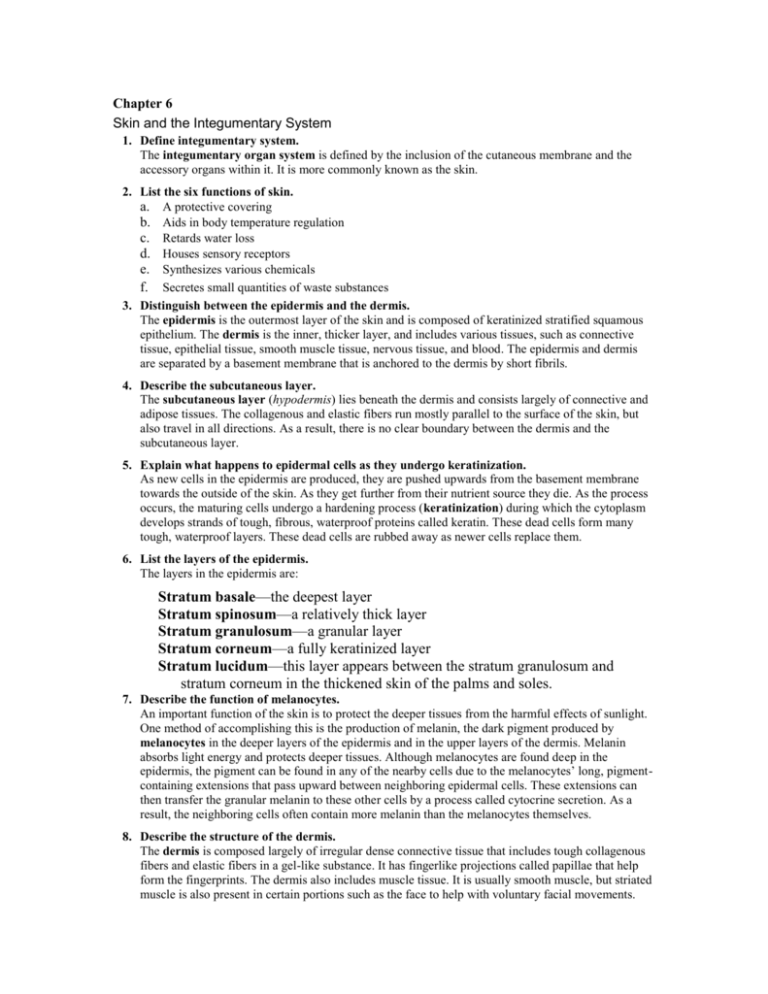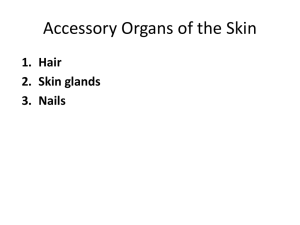Chapter 1
advertisement

Chapter 6 Skin and the Integumentary System 1. Define integumentary system. The integumentary organ system is defined by the inclusion of the cutaneous membrane and the accessory organs within it. It is more commonly known as the skin. 2. List the six functions of skin. a. A protective covering b. Aids in body temperature regulation c. Retards water loss d. Houses sensory receptors e. Synthesizes various chemicals f. Secretes small quantities of waste substances 3. Distinguish between the epidermis and the dermis. The epidermis is the outermost layer of the skin and is composed of keratinized stratified squamous epithelium. The dermis is the inner, thicker layer, and includes various tissues, such as connective tissue, epithelial tissue, smooth muscle tissue, nervous tissue, and blood. The epidermis and dermis are separated by a basement membrane that is anchored to the dermis by short fibrils. 4. Describe the subcutaneous layer. The subcutaneous layer (hypodermis) lies beneath the dermis and consists largely of connective and adipose tissues. The collagenous and elastic fibers run mostly parallel to the surface of the skin, but also travel in all directions. As a result, there is no clear boundary between the dermis and the subcutaneous layer. 5. Explain what happens to epidermal cells as they undergo keratinization. As new cells in the epidermis are produced, they are pushed upwards from the basement membrane towards the outside of the skin. As they get further from their nutrient source they die. As the process occurs, the maturing cells undergo a hardening process (keratinization) during which the cytoplasm develops strands of tough, fibrous, waterproof proteins called keratin. These dead cells form many tough, waterproof layers. These dead cells are rubbed away as newer cells replace them. 6. List the layers of the epidermis. The layers in the epidermis are: Stratum basale—the deepest layer Stratum spinosum—a relatively thick layer Stratum granulosum—a granular layer Stratum corneum—a fully keratinized layer Stratum lucidum—this layer appears between the stratum granulosum and stratum corneum in the thickened skin of the palms and soles. 7. Describe the function of melanocytes. An important function of the skin is to protect the deeper tissues from the harmful effects of sunlight. One method of accomplishing this is the production of melanin, the dark pigment produced by melanocytes in the deeper layers of the epidermis and in the upper layers of the dermis. Melanin absorbs light energy and protects deeper tissues. Although melanocytes are found deep in the epidermis, the pigment can be found in any of the nearby cells due to the melanocytes’ long, pigmentcontaining extensions that pass upward between neighboring epidermal cells. These extensions can then transfer the granular melanin to these other cells by a process called cytocrine secretion. As a result, the neighboring cells often contain more melanin than the melanocytes themselves. 8. Describe the structure of the dermis. The dermis is composed largely of irregular dense connective tissue that includes tough collagenous fibers and elastic fibers in a gel-like substance. It has fingerlike projections called papillae that help form the fingerprints. The dermis also includes muscle tissue. It is usually smooth muscle, but striated muscle is also present in certain portions such as the face to help with voluntary facial movements. The dermis contains both sensory and motor nerves. It also contains blood vessels, hair follicles, sebaceous glands, and sweat glands. 9. Review the functions of the dermal nervous tissue. The dermal nervous tissue has both sensory and motor fibers. Sensory fibers include Pacinian corpuscles, which are stimulated by heavy pressure and Meissner’s corpuscles, which are sensitive to light touch. The motor fibers stimulate dermal muscles and glands. 10. Explain the functions of the subcutaneous layer. The subcutaneous layer contains adipose tissue that acts as an insulator, conserving internal body heat and preventing the entrance of heat from the outside. This layer also contains the major blood vessels that supply nutrients and oxygen to the skin. 11. Distinguish between a hair and a hair follicle. Hair is present on all skin surfaces except the palms, soles, lips, nipples, and various parts of the external reproductive organs. A hair follicle is a group of epidermal cells at the base of a tubelike depression. The root of the hair occupies this follicle. As these cells divide and grow, they are pushed toward the surface and undergo keratinization and subsequent cell death. The cells’ remains form the structure of a developing hair whose shaft extends away from the skin surface. This shaft is called the hair. 12. Review how hair color is determined. Genes that direct the type and amount of pigment produced by epidermal melanocytes determine hair color. Bright red hair contains an iron pigment (trichosiderin) that does not occur in hair of any other color. Gray hair is the result of a mixture of pigmented and unpigmented hair. 13. Describe how nails are formed. Stratified squamous epithelial cells in the region known as the nail root form nails. The whitish halfmoon-shaped area called the lunula marks the nail root. As these cells are pushed outward, they are keratinized into a hard tissue that slides forward over the nail bed to which it remains attached. 14. Explain the function of sebaceous glands. Sebaceous glands contain groups of specialized epithelial cells and are usually associated with hair follicles. They are holocrine glands that secrete an oily substance called sebum (a mixture of fatty materials and cellular debris) that serve to keep the hair and skin soft, pliable, and relatively waterproof. 15. Distinguish between eccrine and apocrine sweat glands. Certain sweat glands, known as apocrine glands, respond to emotional stress and become active when a person is emotionally upset, frightened, or experiencing pain. They are most numerous in the armpits and groin. These are usually connected to hair follicles. The development of these glands is stimulated by sex hormones so they become mature at puberty. Eccrine glands are not associated with hair follicles, and function throughout life in response to elevated body temperature associated with environmental heat and physical exercise. These sweat glands are found primarily on the forehead, neck, and back where they produce profuse sweating. 16. Explain the importance of body temperature regulation. Body temperature regulation is vitally important because even slight shifts in body temperature can disrupt the rates of metabolic reactions. 17. Describe the role of the skin in promoting the loss of excess body heat. In intense heat, the nerve impulses stimulate the skin and other organs to release heat. The muscles when active, release heat. The peripheral blood vessels dilate (vasodilation) which allows more of the warmed blood to be close to the outside for dispersal by radiation. The deeper blood vessels constrict (vasoconstriction) forcing more blood to the surface. The heart rate increases to circulate the blood faster. The sweat glands are also stimulated to add perspiration to the skin for evaporation. 18. Explain how body heat is lost by radiation. Radiation is the primary means of body heat loss. This is accomplished when infrared heat rays escape from warmer surfaces to cooler surroundings. 19. Distinguish between conduction and convection. Conduction is the process by which heat moves directly into the molecules of cooler objects in contact with its surface. Convection is the process by which heat is carried away from the body by air molecules that circulate over the body. 20. Describe the body’s responses to decreasing body temperature. As excessive body heat is lost, the brain triggers responses in skin structure. For example, the muscles in the walls of the dermal blood vessels contract, decreasing the blood flow. The sweat gland become inactive and skeletal muscles throughout the body contract slightly (shivering). 21. Review how air saturated with water vapor may interfere with body temperature regulation. The air can only hold so much of the water molecules. If it is already saturated, the person who is sweating will not have evaporation occur and they will be wet and uncomfortable. 22. Explain how environmental factors affect skin color. Factors such as sunlight, ultraviolet light, and X-rays stimulate increased melanin production. 23. Describe three physiological factors that affect skin color. The dermal blood supply affects skin color. For example, when the blood is well oxygenated, the hemoglobin makes the skin appear pinkish. When the blood is not well oxygenated, the hemoglobin is darker and the skin appears bluish (cyanosis). If the blood vessels are dilated or constricted, the skin will carotene, which is especially common in yellow vegetables, may give the skin a yellowish cast. Illnesses may affect skin color. 24. Distinguish between the healing of shallow and deeper breaks in the skin. If the break in the skin is very shallow, the epithelial cells along the margin are stimulated to reproduce more rapidly. These newly produced cells simply fill in the gap. A deeper break involves the blood vessels. The clot will form and tissue areas will seep into the area and dry. This will then form a scab for underlying protection. Fibroblasts then produce fibers that bind the edges of the wound together. Growth factors are released to stimulate damaged tissue replacement. Healing continues beneath the scab, which sloughs off, when healing is complete. 25. Distinguish among first-, second-, and third-degree burns. A first-degree burn is a superficial partial-thickness burn. An example would be a sunburn. A seconddegree burn is a deep partial-thickness burn. Any burn that blisters is a second-degree burn. A thirddegree burn is a full-thickness burn. It can burn away all the skin and muscles leaving bone exposed. 26. Describe possible treatments for a third-degree burn. Skin grafts are one possible treatment. An autograft is a piece of skin from the victim. A homograft is one from a cadaver. Skin grafts leave scaring. 27. List three effects of aging on the skin. Aging skin affects appearance as “age spots” or “liver spots” appear and grow, along with wrinkling and sagging. Due to changes in the number of sweat glands and shrinking capillary beds in the skin, elderly people are less able to tolerate the cold and cannot regulate heat. Older skin has a diminished ability to activate vitamin D necessary for skeletal health.











